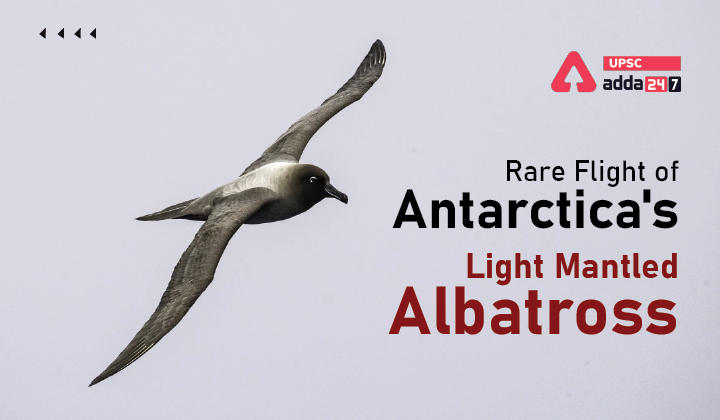Table of Contents
LIGHT MANTLED ALBATROSS- Relevance for UPSC Exam
General Studies III- Conservation, environmental pollution and degradation, environmental impact assessment.
IN NEWS
The Light-mantled Albatross that was spotted on the Rameswaram coast in Tamil Nadu.
LIGHT MANTLED ALBATROS
- First described as Phoebetria Palpebrata by Johann Reinhold Forster, in 1785 the light-mantled albatross also known as the grey-mantled albatross or the light-mantled sooty albatross.
- Appearance: Ash coloured with darker area around the head and lighter areas across the back and wingtips. Black bill. Distinctive white stripe immediately above the eye.
- Light-mantled Albatrosses are generally surface-fishers, diving only about 5 metres on average.
- Light-mantled Albatrosses tend to be solitary while at sea, and only form loosely-associated breeding colonies, if at all, during the mating season.
- By using a combination of wind currents and gravity (referred to as “dynamic soaring”) Light-mantled Albatrosses can fly 110 metres with a drop of only 5 metres as the cost. They can fly at speeds of over 110 km per hour.
- The Light-mantled Albatross, with broad pelagic habits, maintains a circumpolar distribution in the Southern Ocean.
- It breeds on several sub-Antarctic islands, such as Macquarie Islands, Heard Island and McDonald Islands (Australia), South Georgia Island (British Overseas Territory), Prince Edward Islands (South Africa), Iles Kerguelen and Iles Crozet (France), and Auckland, Campbell, and Antipodes Islands (New Zealand).
- The species forage over cold Antarctic waters as far south as the pack ice in summer.
IUCN RED LIST STATUS
- ‘Near Threatened’-IUCN Red List because of diminishing population mainly due to being trapped as bycatch in longline fisheries and also, perhaps, due to the effects of imported predators (BirdLife International 2022).
- Worldwide population was estimated in 1998 to be 21,600 breeding pairs.
RESEARCHER’s VIEW
- Sighting of Antarctica’s native Light Mantled Albatross in the Palk Bay side of Rameswaram island is significant, and it throws up new challenges to researchers once these Antarctic birds migrate to Asia.
- Researchers will be compelled to look for bird migration away from the well-known and established routes and sites. The location where the Albatross was spotted is part of the Palk Bay and near the Gulf of Mannar, an ‘Important Bird Area’ on India’s southeast coast.
- The nearest recorded site of the bird is around 5,000 km away from Rameswaram, the researchers feel a change in atmospheric pressure could have been among the reasons for the Albatross to land on an Indian shore.
TRIGGERED MECHANISM ACCORDING TO RESEARCHERS
- Changes in the wind pattern triggered by global warming are bringing strange birds to our region.
- Changes happening in the wind pattern owing to the increase in atmospheric temperature is affecting birds like albatross, that are known to be on the move, use the wind and save their energy during flights.
- Slight changes in the temperature can cause drastic changes in the wind pattern and birds could land in far-away places that are not familiar to them.
CONSERVING THE MIGRATORY BIRDS-What can be done?
- Monitoring the migration trends in birds, diseases monitoring and enumeration.
- Spreading awareness among the public about importance of bird migration and its impact.
- Commercial activities should be banned along the coastal regions or water bodies during the migration season.
- Pollution of water bodies should be controlled.
- People need to ensure sustainable use of landscapes and ecosystem services, which can support the migratory bird’s site, species and their population
- Conservation of wetlands, grasslands, natural habitats and forests with native species to help birds roost and build their nests
- Banning single use plastics and avoiding dumping of single use plastics in water bodies
- Specific rules, regulations, acts and treaties among nations and strict adherence to support conservation of migratory birds




 TSPSC Group 1 Question Paper 2024, Downl...
TSPSC Group 1 Question Paper 2024, Downl...
 TSPSC Group 1 Answer key 2024 Out, Downl...
TSPSC Group 1 Answer key 2024 Out, Downl...
 UPSC Prelims 2024 Question Paper, Downlo...
UPSC Prelims 2024 Question Paper, Downlo...
